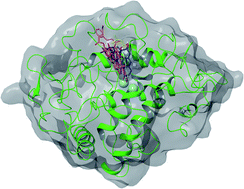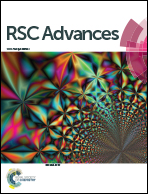Computational approaches to predict binding interactions between mammalian tyrosinases and (S)-(+)-decursin and its analogues as potent inhibitors†
Abstract
Tyrosinase is a metalloprotein involved in the production of melanin, but overexpression of this pigment is problematic in dermatological disorders. (S)-(+)-Decursin and its analogues have been shown to exhibit inhibitory activities against melanin production in B16 murine melanoma cells and specifically inhibit tyrosinase. In order to elucidate their binding modes with mouse tyrosinase, we used computational methods to predict the structures of the complexes on the atomic level. In addition, the structure of human tyrosinase, which has high amino acid sequence identity with mouse tyrosinase, was studied to identify the possible binding mode and activity of (S)-(+)-decursin and its analogues for human treatment. The results showed that (S)-(+)-decursin and its analogues contain ester derivatives that interact with hydrophobic and aromatic residues, particularly Ile256 and Val265 in the binding site. Although human tyrosinase displayed similar interactions with the compounds, there was a key structural difference in residue 222, which caused some compounds to bind with lower binding affinities. Our results provide a foundation for the identification of new tyrosinase inhibitors for treating dermatological disorders.


 Please wait while we load your content...
Please wait while we load your content...